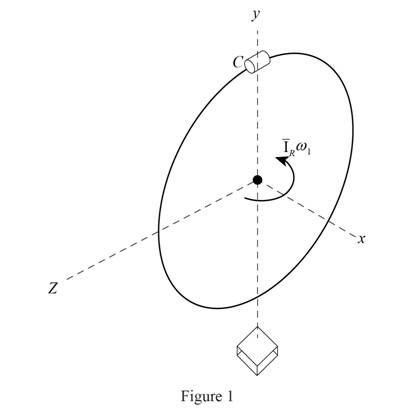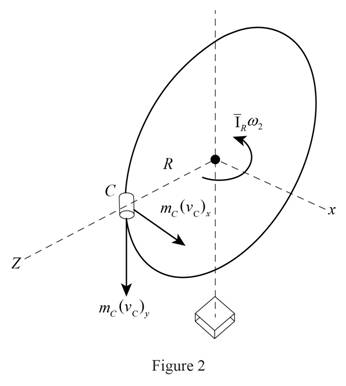
A small 4-lb collar C can slide freely on a thin ring of weight 6 lb and radius 10 in. The ring is welded to a short vertical shaft, which can rotate freely in a fixed bearing. Initially, the ring has an angular velocity of 35 rad/s and the collar is at the top of the ring (θ = 0) when it is given a slight nudge. Neglecting the effect of friction, determine (a) the angular velocity of the ring as the collar passes through the position θ = 90°, (b) the corresponding velocity of the collar relative to the ring.

Fig. P17.91
(a)
Find the angular velocity of the ring as the collar passes through the position
Answer to Problem 17.91P
The angular velocity of the ring as the collar passes through the position
Explanation of Solution
Given information:
The weight
The weight
The initial angular velocity
Calculation:
Find the mass
Substitute 4 lb for
Find the mass
Substitute 6 lb for
Sketch the component of velocity of the given system at initial position as shown in Figure (1).

Find the centroidal moment of inertia
Here, R is the radius of the ring.
The collar C is located at top of the ring at initial position. Therefore, the angle
Sketch the component of velocity of the given system at final position as shown in Figure (2).

Refer Figure (2).
Write the equation of the velocity
Here,
Consider the conservation of angular momentum.
Substitute
Simplify the Equation.
Substitute
Thus, the angular velocity of the ring as the collar passes through the position
(b)
Find the corresponding velocity of the collar relative to the ring.
Answer to Problem 17.91P
The corresponding velocity of the collar relative to the ring is
Explanation of Solution
Calculation:
Find the equation of the kinetic energy
Substitute
Find the equation of the potential energy
Find the equation of the kinetic energy
Substitute
The potential energy of the system at final position
Consider the conservation of energy.
Substitute
Substitute
Thus, the corresponding velocity of the collar relative to the ring is
Want to see more full solutions like this?
Chapter 17 Solutions
VECTOR MECHANIC
Additional Engineering Textbook Solutions
Java: An Introduction to Problem Solving and Programming (8th Edition)
Starting Out With Visual Basic (8th Edition)
Mechanics of Materials (10th Edition)
Electric Circuits. (11th Edition)
Thermodynamics: An Engineering Approach
Management Information Systems: Managing The Digital Firm (16th Edition)
- Assume the xy plane is level ground, and that the vertical pole shown in the diagram lies along the z-axis with its base at the origin. If the pole is 5 m tall, and a rope is used to pull on the top of the pole with a force of 400 N as shown, determine the magnitudes of the parallel and perpendicular components of the force vector with respect to the axis of the post i.e. with respect to the z-axis.arrow_forward4-1 Q4: Q5: (20 Marks) Find √48 using False Position Method with three iterations. Hint: the root lies between 3 and 4. (20 Marks)arrow_forwardDetermine the angle between vectors FA and FB that is less than 180 degrees. FA is the vector drawn from the origin to point A (-4, 4, 2) while FB is the vector drawn from the origin to point B (3, 1, -3).arrow_forward
- Find the resultant force vector from adding F1, F2 and F3, where … F1 = {-8i+10j-32k} N F2 is 40 N in magnitude with coordinate direction angles α, β, and γ, of 45, 120 and 60 degrees, respectively and F3 is 22 N in magnitude with transverse and azimuth angles of 65 and 40 degrees, respectively Express your final answer as a Cartesian vector as well as a magnitude with angles.arrow_forwardA 2-kW resistance heater wire with thermal conductivity of k=20 W/mK, a diameter of D=4mm, and a length of L=0.9m is used to boil water. If the outer surface temp of the resistance wire is Ts=110 degrees C, determine the temp at the center of the wire.arrow_forwardA flat-plate solar collector is used to heat water by having water flow through tubes attached at the back of the thin solar absorber plate. The absorber plate has emmisssivity and an absorptivity of 0.9. The top surface where x=0 temp of the absorber is T0=35 degrees C, and solar radiation is incident on the basorber at 500 W/m^2 with a surrounding temp of 0 degrees C. The convection heat transfer coefficient at the absorber surface is 5 W/m^2 K, while the ambient temp is 25 degrees C. Show that the variation of the temp in the basorber plate can be expressed as T(x)=-(q0/k)x+T0, and determine net heat flux, q, absorbed by solar collector.arrow_forward
- Using properties of a saturated water, explain how you would determine the mole fraction of water vapor at the surface of a lake when the temp of the lake surface and the atmospheric pressure are specified.arrow_forwardConsider a glass of water in a room at 15 degrees C and 97 kPa. If the relative humidity in the room is 100 percent and the water and the air are in thermal and phase equilibrium, determine the mole fraction of the water vapor in the air and the mole fraction of air in the water.arrow_forwardStaring with an energy balance on a cylindirical shell volume element, derive the steady one dimensional heat conduction equation for a long cylinder with constant thermal conductivity in which heat is generated at a rate of egen.arrow_forward
- Consider a round potato being baked in an oven. Would you model the heat transfer to the potato as one, two, or three dimensional? Would the heat transfer be steady or transient? Also, which coordinate system would you use to solve this problem, and where would you place the origin? Explain.arrow_forward0 = 6 a = 25 t = 3 Y b = 30 xarrow_forwardSolve this problem and show all of the workarrow_forward
 Elements Of ElectromagneticsMechanical EngineeringISBN:9780190698614Author:Sadiku, Matthew N. O.Publisher:Oxford University Press
Elements Of ElectromagneticsMechanical EngineeringISBN:9780190698614Author:Sadiku, Matthew N. O.Publisher:Oxford University Press Mechanics of Materials (10th Edition)Mechanical EngineeringISBN:9780134319650Author:Russell C. HibbelerPublisher:PEARSON
Mechanics of Materials (10th Edition)Mechanical EngineeringISBN:9780134319650Author:Russell C. HibbelerPublisher:PEARSON Thermodynamics: An Engineering ApproachMechanical EngineeringISBN:9781259822674Author:Yunus A. Cengel Dr., Michael A. BolesPublisher:McGraw-Hill Education
Thermodynamics: An Engineering ApproachMechanical EngineeringISBN:9781259822674Author:Yunus A. Cengel Dr., Michael A. BolesPublisher:McGraw-Hill Education Control Systems EngineeringMechanical EngineeringISBN:9781118170519Author:Norman S. NisePublisher:WILEY
Control Systems EngineeringMechanical EngineeringISBN:9781118170519Author:Norman S. NisePublisher:WILEY Mechanics of Materials (MindTap Course List)Mechanical EngineeringISBN:9781337093347Author:Barry J. Goodno, James M. GerePublisher:Cengage Learning
Mechanics of Materials (MindTap Course List)Mechanical EngineeringISBN:9781337093347Author:Barry J. Goodno, James M. GerePublisher:Cengage Learning Engineering Mechanics: StaticsMechanical EngineeringISBN:9781118807330Author:James L. Meriam, L. G. Kraige, J. N. BoltonPublisher:WILEY
Engineering Mechanics: StaticsMechanical EngineeringISBN:9781118807330Author:James L. Meriam, L. G. Kraige, J. N. BoltonPublisher:WILEY





